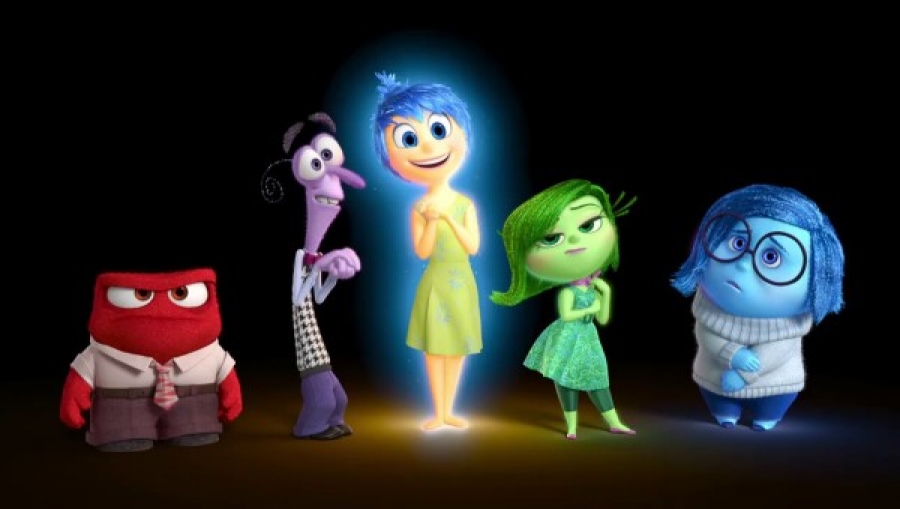Reporting from The Los Angeles Film Festival produced by Film Independent.
They’re back. And, in a big, big way.
It’s been almost two years since last we heard from the artists at Pixar Animation Studios. Their last film was Monsters University back in the summer of 2013. The gap in releases was caused by their decision to retool a movie called The Good Dinosaur. It wasn’t working, so they decided to rip up the script and push back its release by 18 months. In the modern movie business, where release dates are more valuable than screenplays, it’s nearly unheard of for a major release to stop mid-production, switch directors, and make major changes. Pixar did it famously by doing a major overhaul of Ratatouille several years ago. They’ve been known to scrap entire projects that simply weren’t coming together. Who else does that? The Good Dinosaur finally arrives in November.
Their latest film, Inside Out, is very much worth the wait. Directed by Pete Docter (who directed Monsters Inc. and the Oscar winner, Up), the film deals with the emotional turmoil that occurs when an 11-year-old girl named Riley moves with her family from Minnesota to San Francisco, when her dad gets a new job. Riley’s mind is visualized as a control room, and the control room is operated by Riley’s emotions: Joy (voiced by Amy Poehler); Anger (Lewis Black); Sadness (Phyllis Smith from The Office); Disgust (Mindy Kaling); and Fear (Bill Hader). Up until now, Joy has largely been the main driver of Riley’s emotions, creating a few core memories that generate themed islands that make up Riley’s personality. Riley’s memories and personality have been mostly guided by Joy, but Sadness is about to make her presence felt in a really big way.
On Riley’s first day at her new school, Sadness turns one of the core joyful memories sad. While Joy tries to correct the matter, she, Sadness, and the core memories are all sucked out of the control room to the back of Riley’s mind. Without the core memories, Riley has no personality and risks losing the ability to feel. With Joy and Sadness out of the way, Riley is being driven by Anger, Fear, and Disgust.
While making their way back to the control room, Joy and Sadness travel through Riley’s long-term memory and meet her old imaginary friend Bing Bong (Richard Kind), who has been forgotten about and roaming around for years. He guides them through Riley’s subconscious and offers an attempt to get back to the control room.
Okay, first of all, it’s spectacularly good, one of the best films of the year so far. I’m not much of an Oscar prognosticator by any means, but I can’t imagine a better animated film coming out this year.
Pixar is the gold standard, and their misses are like Beatles B-sides. They’ve been so successful at creating their brand both creatively and commercially that it’s easy to wonder why the rest of the industry simply doesn’t adopt a similar level of quality control. It’s a beautifully animated film – colorful, vibrant, and alive.
The film is a deft mix of comedy and genuinely heartfelt emotion, which is so often strived for but so infrequently achieved. I was a little bit worried going in about some of the voice casting, that Lewis Black as Anger was a little too on the nose or that Joy seemed way too much like Poehler’s ultra-positive Leslie Knope character in the great Parks and Recreation. But, the cast is a knockout of comedy pros, and there are some really big laughs. A sequence in which Riley’s dreams are visualized as a movie studio is particularly amazing, and I loved the occasional peeks into the emotional control rooms of the other characters in the movie, particularly Riley’s teacher. Animation offers its filmmakers limitless creativity, and Inside Out delivers it. It also delivers in its more emotional moments, as the emotionally wounded Riley is vulnerable and confused and making some scary decisions.
But, like the best Pixar, Inside Out offers some real intelligence and thematic depth. Yes, it’s a big, colorful movie with a lot of humor, but this may be one that plays more to the grownups. We live in a society in which we’re always trying to pursue our own happiness at the expense of our other emotions, as if feeling them is somehow invalid or maybe even dangerous. Inside Out assures us that our emotions are supposed to be more complex as we get older, and that it’s okay to be sad sometimes. Our personalities will change and grow more expansive as we grow up. On her journey back to the control room, Joy realizes that Riley’s happiest memories often come as a result of some sadness she felt. Joy realizes that sadness is something that’s okay to feel, and that Sadness can be a valid part of the adult Riley will become. Joy comes to understand that sadness is important and needs to be expressed. In a family film, with their easy, but often empty “you can be anything” platitudes, what Docter and his team have done is almost subversive.
I don’t have kids, but I would imagine this movie is going to be a godsend to parents of young children or school teacher or childcare workers when it comes to helping kids process and talk about their own feelings.
If you can’t tell, I really liked it a lot. It’s as good as anything Pixar has made in the past, and people will debate endlessly about how far up it should be ranked. For me, it’s their best since Wall*E.
A short called Lava about a lonely volcano precedes the feature, and it’s amazingly animated and heartfelt.

